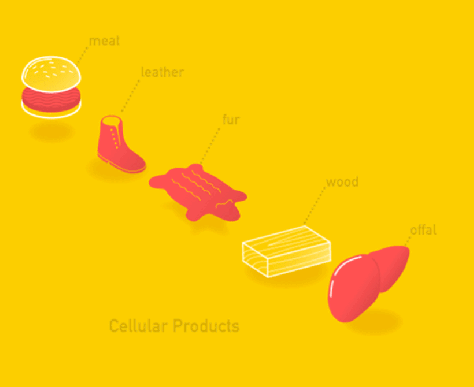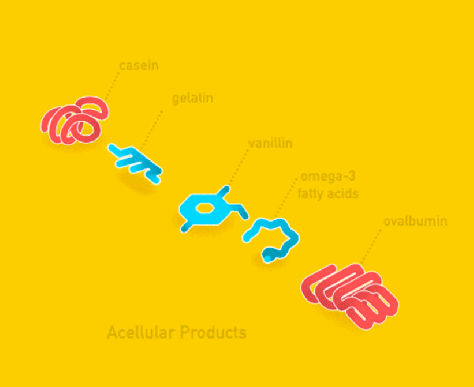Methods
Cellular
The following is a simplified step by step process of the Cellular method
1. Cells or cell lines are taken from living animals using a biopsy procedure, while the animal is under anesthesia.
2. The collected cells, “myosatellite” cells are the stem cells of muscles. The function of these cells is to create new muscle tissue when the muscle is damaged, and needs to be repaired. These myosatellite cells are then placed in a medium, like fetal bovine serum, allowing the cells to culture in an environment that mimics the conditions inside of a cow.
3. Then, the cells are able to multiply inside of a bioreactor just as they would inside of an animal. In order for the cells to differentiate into muscle cells, scientists must stop feeding the intrinsic growth factors of the serum to the culture.
4. Naturally, the muscle cells merge into a 0.3 millimeter long muscle fiber, called a “myotubes.”
5. Next, the myotubes are placed into a gel that is 99% water, helping them form into the shape of muscle fibers.[1]

This method involves harvesting the entirety of the cells themselves. These harvested cells are then grown in a different, controlled environment and then put together to make long muscle strands, and ultimately meat, leather, fur, and other cellular products.
Acellular

The following is a simplified step by step process of the Acellular method
1. A microbe, such as yeast or bacteria, is used in a controlled environment similar to that of the cellular and fermentation process.
2. The microbe is altered by inserting the blueprints for the preferred protein such as casein, or gelatin.
3. Similar to fermentation, the cells will read the gene and produce the preferred protein as if it was its own.
4. The microbe will now be able to make the proteins on its own and is suitable for production in a larger scale. This starter culture is only necessary to be created once. [2]
The fermentation process is an identical method. The only difference is that it requires additional steps and time to complete the process and the main goal is only to enhance the flavors of the products that are created.[3]
Fermentation
Fermentation is one of the oldest scientific processes to be harnessed for food production, giving us alcohol, yogurt, kimchi, kombucha, and some pickled foods. Some forms of fermentation fall under the cellular agriculture umbrella as well. [3]
The following is a simplified step by step process of Fermentation
1. The gene encoding protein is taken from an organism such as a cow and inserted into the DNA of a host organism. This is called DNA synthesis.
2. The host will read the gene and produce proteins of its own.
3. As it produces more proteins, the host is then grown in large quantities under controlled and sterile conditions via a stirred tank bioreactor.
4. The tank is then introduced with a pure culture of the production strain cells that produce the protein
5. The protein is then separated from the cells and purified.
6. The protein is tested for purity.[4]
